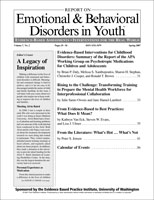Reasons to Consider Assessing for Bipolar Disorder in Children and Adolescents and Practical Steps to Take
Author: Eric Youngstrom, Ph.D..
Source: Volume 06, Number 01, Winter 2006 , pp.5-8(4)

< previous article |next article > |return to table of contents
Abstract:
Pediatric bipolar disorder is one of the most trendy and controversial diagnoses in child mental health at the moment, and it has received tremendous media attention. Rates of diagnosis have increased dramatically, yet some leading epidemiological studies have found few if any cases of bipolar disorder in youths. There is also disagreement about the extent to which the clinical presentation of youths diagnosed with bipolar disorder matches the common clinical picture in adults with bipolar disorder. As a result of the controversies, many responsible and informed practitioners are reluctant to consider diagnosing bipolar disorder, especially in pre-pubertal children. There is a growing body of evidence, however, that severe mood dysregulation and behavior problems can occur in childhood and adolescence, including patterns that can meet strict DSM-IV criteria for bipolar disorders. This article briefly reviews some of the evidence and provides practical and evidence-based recommendations for assessing bipolar disorder in youths. The recommendations strike a balance between being open to the possibility of encountering bipolar disorder in youths and being skeptical of overdiagnosis, and they urge that decisions be informed by reliance on data whenever possible.Keywords:
Affiliations:
1: Departments of Psychology and Psychiatry, Case Western Reserve University.